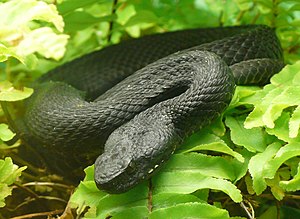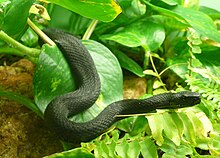Caucasian Otter
| Caucasian Otter | ||||||||||||
|---|---|---|---|---|---|---|---|---|---|---|---|---|

Caucasian viper ( Vipera kaznakovi ), melanistic |
||||||||||||
| Systematics | ||||||||||||
|
||||||||||||
| Scientific name | ||||||||||||
| Vipera kaznakovi | ||||||||||||
| Nikolsky , 1909 |
The Caucasus Otter ( Vipera kaznakovi ) is a species of the real otters ( Vipera ) within the Vipers (Viperidae). Their distribution is limited to the western Caucasus to the Black Sea and northeastern Anatolia and joins the distribution area of the western Caucasus otter ( V. dinniki ). The scientific name honors the Russian zoologist Alexander N. Kaznakov (1872–1933).
features
The Caucasian viper reaches an average length of around 50 cm, with the females becoming larger than the males and in individual cases up to 75 cm. The basic color is light yellow, beige to brick-red or gray-brown to dark gray with a back drawing of a wide, dark and sharply defined zigzag or diamond band that can merge into a wide strip with slight bulges and take up almost the entire body surface. The sides of the body have large oval and dark spots. Occasionally there are completely black, so-called melanistic individuals. The top of the head is dark with small light spots, there is a V-shaped mark on the nape of the neck and a dark band of temples extends over the eyes.
The head is clearly separated from the rest of the body. The eyes have vertical pupils . On the top of the head, the forehead shield , the parietals and the over-eye shields are large, but can also be divided. The remaining shields are broken up into small individual scales. About the eye shield forms the rostral a sharp edge, the nostril is surrounded by the nasal . Below the eyes there is a series of under eye shields (subocularia), underneath are 9 upper lip shields ( supralabials ). The body scales are keeled. There are usually 21 to 23 rows of scales around the middle of the body. The under- tail shields ( Subcaudalia ) are divided as in all species of the genus.
distribution and habitat
The Caucasian otter is found only in the western Caucasus to the Black Sea and northeastern Anatolia. As a habitat, the animals prefer densely overgrown and moist forest areas and mountain forests rich in undergrowth; they also occur on alpine meadows and in agricultural areas. Altitudes of up to 2,000 meters can be reached.
Way of life
The Caucasus otter is diurnal. She is very shy and usually hides. It sunbathes in low bushes and disappears when there is a disturbance. The hibernation is only brief in this species. It feeds mainly on small mammals such as mice and rats as well as lizards and young birds, which it kills with a poison bite. Young snakes feed on grasshoppers and young lizards.
The snake is viviparous ( oviviviparous ).
Snake venom
The poison of the Caucasus Otter is like all Vipera TYPES hemotoxic , medical treatment with an appropriate antivenin is necessary.
literature
- David Mallow, David Ludwig, Göran Nilson: True Vipers. Natural History and Toxicology of Old World Vipers , Krieger Publishing Company, Malabar (Florida) 2003, pp. 285-287, ISBN 0-89464-877-2
- Ulrich Gruber: The snakes of Europe. Franckh'sche Verlagsbuchhandlung, Stuttgart 1989; Pages 198-199. ISBN 3-440-05753-4 .
- Peter Schulze Niehoff: Keeping in terrariums, reproduction and rearing of the Caucasus viper, Vipera kaznakovi Nikolskij, 1909. Ophidia 2 (2), 2008, pp. 11-18
Web links
- Vipera kaznakovi in The Reptile Database
- Vipera kaznakovi inthe IUCN Red List of Threatened Species 2013.2. Posted by: Boris Tuniyev, Goren Nilson, Aram Agasyan, Nikolai Orlov, and Sako Tuniyev, 2008. Retrieved January 6, 2014.
